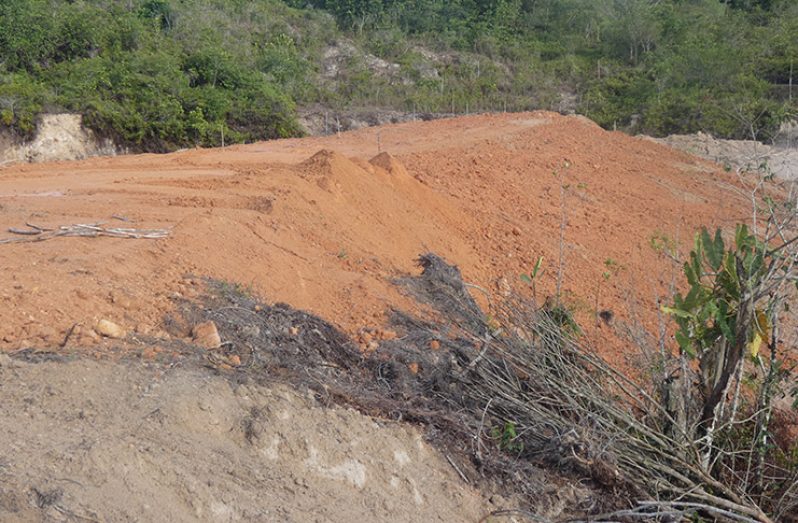– NDIA also dredging the Upper Demerara River
RESIDENTS of the mining community of Coomacka, located up the Upper Demerara River, Region Ten, can now breathe a sigh of relief as the National Drainage and Irrigation Authority (NDIA) has embarked on a programme to stop erosion in the area.
The programme is intended to alleviate the filtering of bauxite sediments and other aggregates into the river when it rains, thereby making a section of it virtually impassable, because of the huge buildup of deposits across it. This buildup of deposits has proven to be not only an environmental problem to the hundreds of residents residing at Coomacka but an economic problem as well, since they depend on the river for multiple purposes. The Regional Democratic Council (RDC) has tried assiduously to get the problem rectified by involving all the mining and environmental agencies.
The NDIA, however, stepped up and is presently executing the project, which includes the construction a reinforced laterite dam across the main channel where the water travels with the aggregates when it rains. NDIA Regional Engineer Jeremy Douglas related to this newspaper that while the project will not fully solve the problem, there will be significant reduction in the amount of aggregates that are filtered into the river, and that plans are in store to ensure complete blockage is done in the long run.
In explaining the present work which he is overseeing, Douglas said. “The whole purpose of that is to reduce the energy of the water as it is coming down off of the hill to reduce the energy; that means that it will be able to fall out without going into the Demerara River. But of course, for security reasons and safety, we will have a control and release. So we are putting two tubes in the dam, so that basically, the water will be able to settle, build up to a height, and then come across. So while it is building up, most of the siltation will be behind the dam, and only water would be coming up. So in the long-term, reducing siltation in the river.”
To further correct the issue, NDIA has also commenced dredging of the river, and that huge blockage of bauxite overburden and other aggregates is currently being removed as well as the clearing of other parts. Douglas related that approximately 9500 cubic feet of aggregate is being removed. Earlier in the year, NDIA pegged the double project at $47M.
Other operations will be undertaken to alleviate flooding, which widely occurs in the community. The project is also expected to include land reclamation by revegetation.
Regional Chairman Renis Morian expressed gratitude that the situation is finally being addressed, as he would have made many trips to Coomacka to monitor the situation and sift out every means necessary through multi-agency engagements for a solution. He told residents last Friday that the erosion issue was battling Coomacka since he was a Regional Councillor, and that engagements with the previous administration to have the issue addressed proved futile.
Coomacka resident Oswald Charles expressed appreciation for the works ongoing as it will bring major relief to the residents, since the river plays and important role in their livelihoods. “I feel good that the project was started, It will remove headache from residents now that our lives can return to normal knowing that we depend on the river for so many things, boats have to pass there and can’t pass. We use the river water to wash, cook, bathe and do so many things so this was a major issue for us and we are happy that we are finally seeing some movement,” he said.
This environmental issue plaguing Coomacka is an a result of unregulated mining that occurred in Region Ten for decades, during the former years of bauxite mining. Coomacka experienced much of the impact since it is located in a basin, with huge overburden piles above the residential territory. No form of reclamation was put in place during those days but Bosai’s Senior Technical Service Coordinator, Wainewright Bethune related, that land reclamation is being considered currently.
In addition to Coomacka, several other communities in close proximity to mined out areas, are under similar threat and experience erosion issues as well. One of these is Block 22, on the Wismar Shore. The Future Development Economic Strategy (FEDS), a Cooperative, has embarked on a revegetation project in the Block 22, Lucky Spot Mining area. The project entails the planting of 1000 acacia plants to rebuild the land, which would have lost most of its top soil during mining.




.jpg)










